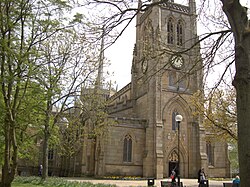Blackburn Cathedral
| Blackburn Cathedral | |
|
The Cathedral Church of Blackburn | |
|---|---|
|
Blackburn, Lancashire | |
| Status: | cathedral |
 Blackburn Cathedral | |
| Church of England | |
| Diocese of Blackburn | |
| Location | |
| Location: | 53°44’50"N, 2°28’53"W |
| History | |
| Built 1820–1967 | |
| Gothic Revival | |
| Information | |
| Website: | www.blackburncathedral.com |
The Cathedral Church of Blackburn St Mary the Virgin with St Paul, commonly known as Blackburn Cathedral is the Church of England cathedral fr the Diocese of Blackburn, which serves central Lancashire. It stands in the heart of Blackburn town centre, in Lancashire, on a site where a church has stood for over a thousand years. The first stone church was built there in Norman times.
The site is ancient but the cathedral is not: it was built slowly over the twentieth century by expanding the standing nineteenth century church.
History
The Diocese of Blackburn was created in 1926, the new bishopric taken from the Diocese of Manchester. As the cathedral of the new diocese, Blackburn’s parish church, St Mary’s was chosen. St Mary’s was an impressive church built in 1826 and designed by architect John Palmer, but it was not considered big enough for its new status and it was determined to expand it. Nevertheless, Palmer’s church stands and now forms the cathedral's nave.
In the early 1930s, fundraising began to enlarge the cathedral so that the building complemented its new importance. By 1938, enough money had been raised and work began on enlarging the new cathedral. Although work was interrupted by the war, it was resumed afterwards and continued through the 1950s and into the early 1960s. After the death of architect W.A. Forsyth in 1950, architect Laurence King joined the project and designed the distinctive lantern tower. The lantern tower, which consists of 56 different panes of coloured glass, with a modernist slender aluminium spire, was completed in 1967.
The cathedral was finally completed in 1977 and what had been built over the past decades was finally consecrated as Blackburn Cathedral that year.[1]
The north transept contains eight misericords dating from the 15th century. It is not known at what time they arrived at the Cathedral, but they are believed to have originated at Whalley Abbey. This could mean that they were removed to a builder's yard after the Dissolution, but with the cathedral not being built until the 19th century, this allows for the possibility that they had lain unused for some 300 years.
In 2009 the tower was topped with an ornate bishop's mitre finial painted and gilded in gold leaf by Mark Bridges of Sussex and bearing the Lancashire rose emblem[2]
On 17 April 2015 the Cathedral hosted the Royal Maundy service. In keeping with tradition, The Queen handed out Maundy money to 88 men and 88 women. It was the Queen's first visit to the Cathedral.[3]
Music

Choir
The cathedral has seven choirs — Boys, Girls, Children's, Lantern Voices, YPC (Young Peoples' Choir), Men and Renaissance (Bach) Choir. On Sundays the Parish Communion is sung by the YPC and the Eucharist and Evensong by the Cathedral Choir (Boys and Men).
Organ
A scheme for an organ in the west gallery was submitted, by John Gray and partner Frederick Davison, two years before the consecration of the new church. The organ was opened on 28 February 1828 with a concert which included works by Handel - extracts from his Messiah and Israel in Egypt and his Occasional Overture played by the new organist Joseph John Harris.[4]
The organ was originally built by David Wood in 1994.[5]
Recent developments
In 1998 the lantern tower underwent restoration, being rebuilt in natural stone. The original 1960s tower had been built in concrete. The windows were also replaced.
Further work was carried out in 2000–01 to re-build the east end roofs and parapets and blend them into the existing structures. Upon completion of this work the cathedral was finally deemed to be finished after over 70 years of construction.
As well as this rebuilding a new piece of art was commissioned for the exterior of the building. The sculpture by Mark Jalland, The Healing of The Nations, measuring 35 feet x 26 feet, is an abstract steel and copper circular piece containing thousands of interwoven fibre optics that create ever-changing patterns of light at night. It is deemed by many to be one of the most innovative pieces of modern sculpture at any cathedral.
The cathedral still forms an important part of the community. It is open to visitors and has a gift shop and café as well as hosting numerous events. In February 2011 the Cathedral exhibited the Quaker Tapestry from Kendal.[6]
Pictures
 |
 |
Outside links
| ("Wikimedia Commons" has material about Blackburn Cathedral) |
References
- ↑ "Blackburn Cathedral | Scala". Scalapublishers.com. http://www.scalapublishers.com/title.aspx?category=&subcategory=&id=3603. Retrieved 23 June 2015.
- ↑ "New ornate mitre tops off tower at Blackburn Cathedral" at ancashiretelegraph.co.uk/
- ↑ "Maundy Thursday: Queen hands out money at Blackburn Cathedral - BBC News". Bbc.co.uk. http://www.bbc.co.uk/news/uk-england-lancashire-27052583. Retrieved 23 June 2015.
- ↑ John Bertalot and Richard Tanner publisher=blackburncathedral.com/. "The Organs of Blackburn Cathedral". http://www.blackburncathedral.com/UserFiles/File/The%20Organs%20of%20Blackburn%20Cathedral.pdf. Retrieved 19 May 2013.
- ↑ Dr M D Sayers (2015). "Lancashire Blackburn,Cathedral of St. Mary [E00533"]. The British Institute of Organ Studies 2015. http://www.npor.org.uk/cgi-bin/Rsearch.cgi?Fn=Rsearch&rec_index=E00533. Retrieved 6 July 2015.
- ↑ Quaker Tapestry Exhibition at visitlancashire.com
- Listing designation: National Heritage List 1239147: Blackburn Cathedral
Canon Chris Chivers. Blackburn Cathedral. Scala Arts Publishers. ISBN 978-1-85759-645-8.
| Cathedrals of the Church of England |
|---|
|
Province of York:
Blackburn •
Bradford •
Carlisle •
Chester •
Durham •
Liverpool •
Manchester •
Newcastle upon Tyne •
Peel •
Ripon •
Sheffield •
Southwell •
Wakefield •
York
|